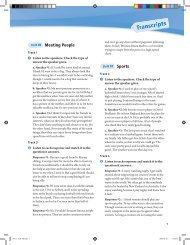Mastering Skills for the TOEFL iBT 2nd - Speaking
Mastering Skills for the TOEFL iBT 2nd - Speaking
Mastering Skills for the TOEFL iBT 2nd - Speaking
You also want an ePaper? Increase the reach of your titles
YUMPU automatically turns print PDFs into web optimized ePapers that Google loves.
TranscriptsQ4 Practice 1Step 1 - LectureW: Although it once wasn’t thought possible,neuroscientists now believe that <strong>the</strong>re are at leasttwo different ways that a damaged adult braincan achieve some amount of recovery.First, in certain areas of our brain . . . cells thathave been lost through damage can be replacedby new ones. In a 1998 study of dead humanbrain tissue, researchers discovered that neurons,or brain cells, can actually re-grow <strong>the</strong>mselvesafter <strong>the</strong>y had suffered damage. Neurons thathave not been damaged can divide into multipleneurons. This ability to regenerate can occurthroughout our lives, allowing areas of <strong>the</strong> adultbrain to recover to a certain degree after seriousbrain damage. Un<strong>for</strong>tunately, this ability can onlyoccur in two areas of <strong>the</strong> brain.The adult brain also has <strong>the</strong> unique ability toreorganize itself so that o<strong>the</strong>r parts assume <strong>the</strong>tasks of <strong>the</strong> damaged area. Take adults who havesuffered from strokes, <strong>for</strong> instance . . . when <strong>the</strong>brain is damaged by a stroke, patients often losesuch functions as motor control, memory, or <strong>the</strong>ability to speak and understand language. However,researchers have found that often what happensafter a stroke is that uninjured—or healthy—areasof <strong>the</strong> brain will reorganize <strong>the</strong>mselves to per<strong>for</strong>m<strong>the</strong> same—or nearly <strong>the</strong> same—functions of <strong>the</strong>damaged areas.Step 3 - Sample ResponseAccording to <strong>the</strong> reading, an adult brain has two waysto recover from brain damage. The professor explainsthat <strong>the</strong> first way is by brain cell re-growth. She saysthat sometimes an adult brain can re-grow cells thatwere lost through damage. She says that this canhappen when undamaged brain cells divide to <strong>for</strong>mnew cells. She <strong>the</strong>n explains <strong>the</strong> second way <strong>the</strong> adultbrain can recover from brain damage—by reorganizingitself. The professor gives <strong>the</strong> example of those whohave suffered from strokes. Sometimes when patientslose certain functions due to a stroke, <strong>the</strong> healthyparts of <strong>the</strong>ir brains are able to change. They can takeover those functions that were found in <strong>the</strong> damagedparts of <strong>the</strong> brain.Q4 Practice 2Step 1 - LectureM: Probably <strong>the</strong> most obvious downside of interactivetelevision is that, like all television, it can influencea child’s intelligence in a bad way. A recent studyshowed that children who are exposed to televisionat a young age score lower on intelligence teststhan do o<strong>the</strong>r children, leading a pediatrics institutionto conclude that children under age two shouldnot be watching television as it could harm <strong>the</strong>mcognitively. Despite this fact, interactive televisionsystems are being made <strong>for</strong> children as young astoddlers. Studies have now estimated that childrenas young as a year old are watching over twohours of television a day. So interactive televisionsimply increases <strong>the</strong> time our children spend infront of <strong>the</strong> TV, thus harming <strong>the</strong>m in <strong>the</strong> long run.Interactive television will also allow advertisers totarget children in new ways. For instance, certaininteractive Internet games have already beendeveloped which advertise products to childrenas <strong>the</strong>y’re playing <strong>the</strong> games. Products like cereal,chocolate chip cookies, and beverages have allbeen advertised through interactive games thatchildren can play. This is a problem becausechildren are inherently vulnerable to advertising.They usually accept what <strong>the</strong>y see or hear asfact. With interactive television, because it oftenworks through an Internet connection, advertiserscan target children based on what <strong>the</strong>y learnabout <strong>the</strong>m—<strong>the</strong>ir gender, age, even <strong>the</strong>ir behaviorsand preferences.Step 3 - Sample ResponseAccording to <strong>the</strong> reading, interactive television cannegatively affect children’s intelligence and allowcompanies to target children. The professor expandson this first point by saying that television has beenshown to be harmful <strong>for</strong> children under <strong>the</strong> age of twoto watch. Tests have shown that it can lower intelligencelevels. Yet <strong>the</strong>re are many interactive television programsout <strong>the</strong>re made especially <strong>for</strong> children under two. Healso says that interactive television allows advertisersto target young children. They can sell specific productsto children based on what <strong>the</strong>y learn about <strong>the</strong>mthrough <strong>the</strong> Internet. Children are easily persuaded by<strong>the</strong>se advertisements and accept what <strong>the</strong>y see orhear as being true.Transcripts 11
















